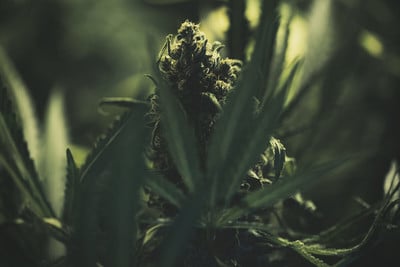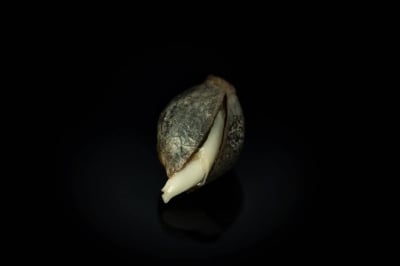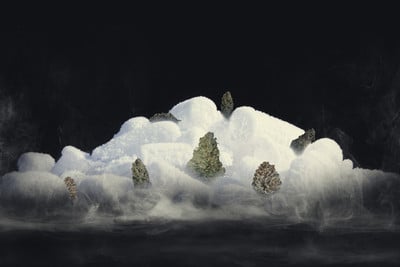.

What Is Reggie Weed and Should You Smoke It?
We've all picked up a bag of reggie weed at some point. It has a tinge of brown. It lacks the stickiness of good bud. It barely has a smell, and feels harsh on the throat. Find out how reggie weed compares to high-grade marijuana, from its effects all the way to how it smokes. Then, we'll explain why some users—surprisingly—don't mind it so much.
Contents:
Have you heard of reggie weed? We’re not talking mids here. Rather, we’re referring to the lowest of the low. The stuff packed with seeds and stems. The stuff that makes you feel lucky when inhaling a single terpene after giving it a whiff. Below, we’re going to take you through the ins and outs of reggie weed, how it compares to good cannabis, and why most cannabis users choose to avoid it.
What Is Reggie Weed?
You’ve seen the term floating around the internet, but what does reggie weed mean? The label was originally used as shorthand for “regular weed”, but it now designates something much worse than that.
Cannabis users reserve this title for the worst of the worst; the kind of bud you pick up from your local herbal entrepreneur that makes you really consider growing your own. It doesn’t just describe your bog-standard mid-level weed. It refers to those browning, overly dry, airy nugs accompanied by an almost equal weight of stalks and seeds. This stuff smells like grass, tastes like ass, and provides nothing but an overall disappointing experience.


How Much THC Is in Reggie Weed?
There is no exact THC range within which reggie weed universally autumns; however, anything under 10% is common. This amount pales in comparison to most modern strains, and ends up costing more money over time to achieve the same high as you would from higher-quality buds.
Reggie vs Dro
As shorthand for “hydroponic”, dro simply refers to cannabis cultivated outside of soil. While some local weed salesmen might use this method of cultivation as a marketing tool, “dro” doesn’t denote the quality of weed—only the growing method. While reggie and dro are often pitched as the antithesis of one another, some growers manage to produce poor-quality buds when growing hydroponically, while others achieve outstanding results in soil.
Reggie Bud: How to Detect It
Now that you’re familiar with reggie weed, and want to do everything you can to avoid spending your hard-earned money on subpar cannabis, what are the telltale signs of this botanical abomination? Thankfully, it doesn’t take 20-20 vision, a microscope, or knowledge of genetic sequencing to distinguish reggie weed from a sample of otherwise acceptable cannabis inflorescences.
Check out the tips below to know what to look for. By the end of this section, you’ll acquire the knowledge to recognise reggie weed using your eyes, nose, and fingers.
What Does Reggie Weed Look Like?
Imagine what you consider to be a pristine cannabis bud. It’s firm, coated in resin, well-manicured, and emits a pleasant and strong terpene profile. Now, imagine the opposite. Reggie weed lacks the frosty appearance of a well-grown bud, appears brown/yellow—as opposed to a vibrant shade of green or purple—and generally looks bad. Instead of a pristine nug, you’ll be met with a loose, airy, and poorly trimmed inflorescence—shrivelled sugar leaves and all. Chances are, you’ll also have purchased a fair few stems and seeds that tipped the scales in the seller's favour.


The Texture of Reggie Weed
You can tell a lot about a cannabis bud by simply handling it. Top-shelf nugs are firm and sticky. Reggie weed, on the other hand, feels a whole lot like disappointment when you place it between your thumb and index finger and give it a squeeze. It lacks firmness, stickiness (i.e. trichomes), and its airy structure offers no resistance. When assessing reggie weed with your hands, your touch receptors might come across several spherical, solid objects lodged into the hay-like mass. Unless you’re intentionally building a collection of bad genetics, don’t sow these seeds.
How Does Reggie Weed Smoke?
What should you expect when smoking reggie weed? It’s something between low-level cannabis available in a dodgy coffeeshop and mown grass left at the mercy of the summer sun. High-quality cured cannabis flowers offer a smooth smoke and a rich terpene profile, whereas reggie weed feels harsh on the throat and lacks the fruity and piney taste of monoterpenes and the spiciness of more complex sesquiterpenes. You’ll detect a few terps here and there, but it almost always autumns short of the flavour of well-grown weed. Oh, and make sure you remove all of the seeds to prevent blowing the end of your joint out.
The Potency of Reggie Weed
Reggie weed is synonymous with weak weed. This all comes down to poor genetics and bad growing practices that lead to poor trichome density. Skilled growers use powerful light and beneficial microbes to drive up trichome count and cannabinoid content. Neglected reggie weed displays no signs of such care and attention, which will be evident in the meagre effects. Plus, poor genetics largely lack the biosynthetic prowess that enables them to produce more cannabinoids from the get-go.
The Aroma of Reggie Weed
Reggie weed lacks the fruity, woody, herbal, and gassy scents of well-grown cannabis. Fewer trichomes, and therefore fewer terpenes, results in a poor aroma and flavour. Furthermore, this kind of cannabis often undergoes incorrect processing, or no processing at all. Poor drying and curing practices result in the loss of volatile monoterpenes, culminating in a rather dull and musky smell that does little to excite the olfactory system.


Why You Shouldn’t Smoke Reggie Weed
Most of the time, you should do everything possible to avoid combusting and inhaling low-grade reggie bud. In the context of recreational use, it offers a disappointing experience that pales in comparison to the effects of good cannabis. Many growers that produce reggie weed are only looking to flip a quick profit, which also increases the likelihood that their buds contain pesticide residue and other noxious chemicals. Those who use cannabis for medical reasons should certainly sidestep reggie weed; these buds are nowhere near an acceptable quality for holistic use.
Do Some People Prefer Reggie Weed?
Believe it or not, some cannabis users favour the subtler effects that reggie weed offers. Of course, nobody willingly goes out of their way to smoke chemical-laden buds packed with seeds and stems. Rather, these individuals are seeking a THC content that is on the milder side, as well as a lower price label.
It’s no secret that many modern cultivars contain excessive THC levels. While some like to smoke the strongest strains during every session, others are looking for a less-pronounced but still notable experience. In this case, though, it’s far better to opt for a high-quality strain with a naturally mild THC content than it is to waste money on a lacklustre product that hasn’t been given the necessary care and attention. Even if reggie weed is cheaper outright, its returns quickly diminish.
What Can You Do With Reggie Weed?
So, what do you do if you find yourself with a bag of reggie weed? Though it’s not going to offer a satisfying smoke on its own, it can be put to use. After all, as long as it still contains some cannabinoids, there is a high to be harnessed from this far-less-than-ideal stash. Here’s what you can do:
- Use it to bulk out a stash of good weed to make it last longer

- Make edibles or tinctures

- Grind it up to collect the trichomes, and use it to make hash



Reggie Weed: To Smoke or Not to Smoke?
And just like that, you’re a fountain of knowledge on reggie weed. At a guess, we’d say you’re pretty likely to steer clear of these low-grade buds going forward. Their poor potency, lack of flavour and aroma, and possible contamination displace them from the menu of most smokers. However, if you have access to nothing else, or simply enjoy milder cannabis, then go ahead and do you. Just make sure whatever you’re smoking doesn’t contain any traces of mould or nasty chemicals.








































